Schedule
Pea Crop Schedule
| Product Name | Fertilizers | |||||||||
|---|---|---|---|---|---|---|---|---|---|---|
| Poornima Kit | NPK Grow Caps |
Rhizo | Humigrow Nano Powder |
Alp | Sonha-Bihan | Amavasya Kit | IBP-Kit | |||
| Humic Acid | Chelated Multi-micronutrient |
PGP/PGR | ||||||||
| Land Reparation | week -2 | |||||||||
| Soil Treatment | week -1 | 1 Kit | ||||||||
| Before Seed Sowing | week 0 | |||||||||
| Germination | week 1 | |||||||||
| Vegetative Growth | week 2 | 1 Kit | 1 Caps | |||||||
| week 3 | ||||||||||
| week 4 | 1 kit | |||||||||
| week 5 | ||||||||||
| week 6 | 1 Caps | 1 Caps | 120gm | 250gm | 250gm | |||||
| week 7 | ||||||||||
| week 8 | ||||||||||
| week 9 | ||||||||||
| Harvesting Flowering/ Fruiting/ |
week 10 | 1 Caps | 1 Caps | 120gm | ||||||
| week 11 | ||||||||||
| week 12 | ||||||||||
| week 13 | ||||||||||
| week 14 | ||||||||||
| Harvesting | ||||||||||
| Total Quantity | 1 Kit | 2 Caps | 3 Caps | 240gm | 250gm | 250gm | 1 Kit | 1 Kit | ||
| Broadcast | |
| Top Dressing | |
| Basal Dressing | |
| Soil Application | |
| Spray | |
| * | Optional |
NOTE: For the first year donot immidietaly substitute 100% chemical fertilizer with the SIESTO GREEN products, as the soil is used to chemical fertilizer, it may affect the output. So the best way to substitute is by reducing 50% of chemical input in the first year, 25% the following 2nd year, & then another 10% by the 3rd year. After the 3rd year use synthetic fertilizer / inorganic fertilizer if their is a requirement depending on the soil health.
CROP SCHEDULE FOR GROUNDNUTCROP
Sr. No.
Treatment / Application
Product
Dose /Acre
APPLICATION
Management
1
Vegetative – Dissolve in 20 to 200 ltr. of water as required for 1 acre of land and apply through Drip Irrigation or drench.
POORNIMA KIT
1 Kit
+
Rhizo caps
Apply after germination that is week 2 and week 9
It is a balanced form of nutrients that includes NPK, Zinc, Cropforce NP, Humigrow NP, and Mycorrhiza NP
2
Vegetative – Mix all with the required amount of water and apply through drip irrigation, flood irrigation, or drenching as per farmer’s availability.
NPK + Rhizo caps +
Humigrow
1 Caps + 120gm
Apply it in week 6 and 10
It is a balanced form of Nutrition that includes NPK.
3
Flowering/ Fruiting – Mix both in 20 – 200 liters of water as per requirement and spray it in the plants.
ALP + Sonhabihan
250gm + 250gm/ 200 lit. of water
Apply it in week 6 (When flower bud are seen) and further more if required
It is a Micronutrient and PGP that helps in Growth, Fruit set, and the quality of the produce.
4
Vegetative and Flowering/ Fruiting – Mix all with the required amount of water and apply through foliar spray or drenching as per infestation of insect.
Amavasya kit
2 kits
Apply it in week 4
It is a balanced form of insecticides. Which include Traps, lifeline ,Bt,Acarida and Meta capsules.
5
Soil Treatment – Dissolve in 20lit. to 200lit. of water as per requirement for 1 acre of land and apply through drip irrigation or drench.
IBP KIT
1 kit
Apply it before sowing
It prevents soil-born diseases and nematodes. Apply as per the soil health and soil-born diseases.
PEST ATTACKS, BACTERIAL, OR FUNGAL MANAGEMENT
PEST / BACTERIAL / FUNGAL
IDENTIFICATION IN CROP
SYMPTOMS
SUGGESTED PRODUCT
Stem fly
 The maggots bore into the stem thereby causing withering and ultimate drying of the affected shoots, thus reducing the bearing capacity of the host plants.The adults also cause damage by puncturing the leaves, and the injured parts turn yellow.
Lifeline + Traps + Meta + BT
Pod borer
The maggots bore into the stem thereby causing withering and ultimate drying of the affected shoots, thus reducing the bearing capacity of the host plants.The adults also cause damage by puncturing the leaves, and the injured parts turn yellow.
Lifeline + Traps + Meta + BT
Pod borer
 At early stage they feed on the foliage and sometime cause serious defoliation.During reproductive stage they bore the developing pod and feed on the seeds with its head typically thrust inside and most of the part of the body outside.
Lifeline + Traps + Meta + BT
Pea Weevil
At early stage they feed on the foliage and sometime cause serious defoliation.During reproductive stage they bore the developing pod and feed on the seeds with its head typically thrust inside and most of the part of the body outside.
Lifeline + Traps + Meta + BT
Pea Weevil
 The larvae burrow straight through the pods to feed on the seed, so are not readily found for identification until seed is mature (above) and it is too late for control.
Traps+Meta
+ BT
Pea aphid
The larvae burrow straight through the pods to feed on the seed, so are not readily found for identification until seed is mature (above) and it is too late for control.
Traps+Meta
+ BT
Pea aphid
 Curling and distortion of leaves, stunting and malformation shoots occur.Leaves turn pale and dry. Honeydew secretion of aphids leads to sooty mould which hinders the photosynthetic activity of the plants.
Lifeline+Traps
+ Meta
Leaf miner
Curling and distortion of leaves, stunting and malformation shoots occur.Leaves turn pale and dry. Honeydew secretion of aphids leads to sooty mould which hinders the photosynthetic activity of the plants.
Lifeline+Traps
+ Meta
Leaf miner
 The large number of tunnels made by the larvae between the lower and upper epidermis interferes with photosynthesis and proper growth of the plants, making them look unattractive. Leaves with serpentine mines Drying dropping of leaves in severe cases.
Lifeline+Traps
+ Meta
Pea pod borer
The large number of tunnels made by the larvae between the lower and upper epidermis interferes with photosynthesis and proper growth of the plants, making them look unattractive. Leaves with serpentine mines Drying dropping of leaves in severe cases.
Lifeline+Traps
+ Meta
Pea pod borer
 Dropping of flowers and young pods.As the larva develops within the pod, faeces accumulate causing soft, rotten patches on the pod.Seeds are either partially or entirely eaten, and considerable frass and silk are present.
Traps + Meta + BT
Downy mildew
Dropping of flowers and young pods.As the larva develops within the pod, faeces accumulate causing soft, rotten patches on the pod.Seeds are either partially or entirely eaten, and considerable frass and silk are present.
Traps + Meta + BT
Downy mildew
 A grayish white, moldy growth appears on the lower leaf surface, and a yellowish area appears on the opposite side of the leaf.Infected leaves can turn yellow and die if weather is cool and damp.Stems may be distorted and stunted. Brown blotches appear on pods, and mold may grow inside pods.
INDOFA
Powdery mildew
A grayish white, moldy growth appears on the lower leaf surface, and a yellowish area appears on the opposite side of the leaf.Infected leaves can turn yellow and die if weather is cool and damp.Stems may be distorted and stunted. Brown blotches appear on pods, and mold may grow inside pods.
INDOFA
Powdery mildew
 it attacks leaves first, producing faint, slightly discolored specks from which grayish white powdery growth of mycelium develop.Powdery growth spread over leaf, stem and pod.The leaves turn yellow and die.The fruits do not set or remain very small.It causes defoliation.Later stages, powdery growth also covers the pods.
INDOFA
Pea rust
it attacks leaves first, producing faint, slightly discolored specks from which grayish white powdery growth of mycelium develop.Powdery growth spread over leaf, stem and pod.The leaves turn yellow and die.The fruits do not set or remain very small.It causes defoliation.Later stages, powdery growth also covers the pods.
INDOFA
Pea rust
 Leaves of infected plants exhibit many small, orange-brown pustules usually at the lower surface.Severely infected leaves wither and may drop from the plant.
INDOFA + Bacillus
Ascochyta blight
Leaves of infected plants exhibit many small, orange-brown pustules usually at the lower surface.Severely infected leaves wither and may drop from the plant.
INDOFA + Bacillus
Ascochyta blight
 Symptoms first appear as small, purplish-brown and irregular flecks. Under continued humid conditions, the flecks enlarge and coalesce, resulting the lower leaves becoming completely blighted.
INDOFA + Bacillus
White rot
Symptoms first appear as small, purplish-brown and irregular flecks. Under continued humid conditions, the flecks enlarge and coalesce, resulting the lower leaves becoming completely blighted.
INDOFA + Bacillus
White rot
 The maximum infection develops at the flowering stage of the crop, when petals fall on ground and these catch infection immediately and mycelial growth of fungus invades the stem and branche.
INDOFA + Bacillus
The maximum infection develops at the flowering stage of the crop, when petals fall on ground and these catch infection immediately and mycelial growth of fungus invades the stem and branche.
INDOFA + Bacillus
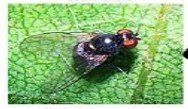 The maggots bore into the stem thereby causing withering and ultimate drying of the affected shoots, thus reducing the bearing capacity of the host plants.The adults also cause damage by puncturing the leaves, and the injured parts turn yellow.
Lifeline + Traps + Meta + BT
Pod borer
The maggots bore into the stem thereby causing withering and ultimate drying of the affected shoots, thus reducing the bearing capacity of the host plants.The adults also cause damage by puncturing the leaves, and the injured parts turn yellow.
Lifeline + Traps + Meta + BT
Pod borer
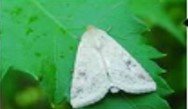 At early stage they feed on the foliage and sometime cause serious defoliation.During reproductive stage they bore the developing pod and feed on the seeds with its head typically thrust inside and most of the part of the body outside.
Lifeline + Traps + Meta + BT
Pea Weevil
At early stage they feed on the foliage and sometime cause serious defoliation.During reproductive stage they bore the developing pod and feed on the seeds with its head typically thrust inside and most of the part of the body outside.
Lifeline + Traps + Meta + BT
Pea Weevil
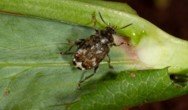 The larvae burrow straight through the pods to feed on the seed, so are not readily found for identification until seed is mature (above) and it is too late for control.
Traps+Meta
+ BT
Pea aphid
The larvae burrow straight through the pods to feed on the seed, so are not readily found for identification until seed is mature (above) and it is too late for control.
Traps+Meta
+ BT
Pea aphid
 Curling and distortion of leaves, stunting and malformation shoots occur.Leaves turn pale and dry. Honeydew secretion of aphids leads to sooty mould which hinders the photosynthetic activity of the plants.
Lifeline+Traps
+ Meta
Leaf miner
Curling and distortion of leaves, stunting and malformation shoots occur.Leaves turn pale and dry. Honeydew secretion of aphids leads to sooty mould which hinders the photosynthetic activity of the plants.
Lifeline+Traps
+ Meta
Leaf miner
 The large number of tunnels made by the larvae between the lower and upper epidermis interferes with photosynthesis and proper growth of the plants, making them look unattractive. Leaves with serpentine mines Drying dropping of leaves in severe cases.
Lifeline+Traps
+ Meta
Pea pod borer
The large number of tunnels made by the larvae between the lower and upper epidermis interferes with photosynthesis and proper growth of the plants, making them look unattractive. Leaves with serpentine mines Drying dropping of leaves in severe cases.
Lifeline+Traps
+ Meta
Pea pod borer
 Dropping of flowers and young pods.As the larva develops within the pod, faeces accumulate causing soft, rotten patches on the pod.Seeds are either partially or entirely eaten, and considerable frass and silk are present.
Traps + Meta + BT
Downy mildew
Dropping of flowers and young pods.As the larva develops within the pod, faeces accumulate causing soft, rotten patches on the pod.Seeds are either partially or entirely eaten, and considerable frass and silk are present.
Traps + Meta + BT
Downy mildew
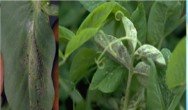 A grayish white, moldy growth appears on the lower leaf surface, and a yellowish area appears on the opposite side of the leaf.Infected leaves can turn yellow and die if weather is cool and damp.Stems may be distorted and stunted. Brown blotches appear on pods, and mold may grow inside pods.
INDOFA
Powdery mildew
A grayish white, moldy growth appears on the lower leaf surface, and a yellowish area appears on the opposite side of the leaf.Infected leaves can turn yellow and die if weather is cool and damp.Stems may be distorted and stunted. Brown blotches appear on pods, and mold may grow inside pods.
INDOFA
Powdery mildew
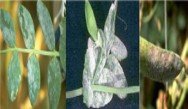 it attacks leaves first, producing faint, slightly discolored specks from which grayish white powdery growth of mycelium develop.Powdery growth spread over leaf, stem and pod.The leaves turn yellow and die.The fruits do not set or remain very small.It causes defoliation.Later stages, powdery growth also covers the pods.
INDOFA
Pea rust
it attacks leaves first, producing faint, slightly discolored specks from which grayish white powdery growth of mycelium develop.Powdery growth spread over leaf, stem and pod.The leaves turn yellow and die.The fruits do not set or remain very small.It causes defoliation.Later stages, powdery growth also covers the pods.
INDOFA
Pea rust
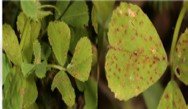 Leaves of infected plants exhibit many small, orange-brown pustules usually at the lower surface.Severely infected leaves wither and may drop from the plant.
INDOFA + Bacillus
Ascochyta blight
Leaves of infected plants exhibit many small, orange-brown pustules usually at the lower surface.Severely infected leaves wither and may drop from the plant.
INDOFA + Bacillus
Ascochyta blight
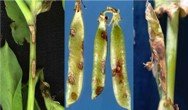 Symptoms first appear as small, purplish-brown and irregular flecks. Under continued humid conditions, the flecks enlarge and coalesce, resulting the lower leaves becoming completely blighted.
INDOFA + Bacillus
White rot
Symptoms first appear as small, purplish-brown and irregular flecks. Under continued humid conditions, the flecks enlarge and coalesce, resulting the lower leaves becoming completely blighted.
INDOFA + Bacillus
White rot
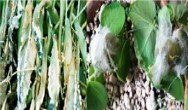 The maximum infection develops at the flowering stage of the crop, when petals fall on ground and these catch infection immediately and mycelial growth of fungus invades the stem and branche.
INDOFA + Bacillus
The maximum infection develops at the flowering stage of the crop, when petals fall on ground and these catch infection immediately and mycelial growth of fungus invades the stem and branche.
INDOFA + Bacillus
NUTRIENTS DEFICIENCY
NUTRIENT
IDENTIFICATION
SYMPTOMS
SUGGESTED PRODUCT
Nitrogen
 · Older growth is first and worst affected old leaves becoming yellow-mottled to marginally chlorotic.
· As deficiency worsens plants becomes stunted and pale; older leaves become progressively pinkish pale and die, leaving green new growth.
Azoss Caps/
Azoto Caps
Phosphorus
· Older growth is first and worst affected old leaves becoming yellow-mottled to marginally chlorotic.
· As deficiency worsens plants becomes stunted and pale; older leaves become progressively pinkish pale and die, leaving green new growth.
Azoss Caps/
Azoto Caps
Phosphorus
 stunting, and darkening in colour of the whole plant. Reddening of stems, petioles, tendrils and leaf margins can occur, particularly if the plant is stressed.
PSB Plus
Potash
stunting, and darkening in colour of the whole plant. Reddening of stems, petioles, tendrils and leaf margins can occur, particularly if the plant is stressed.
PSB Plus
Potash
 Pale grey necrosis of leaf veins (particularly the midrib) of the second oldest leaf.
This is followed by older leaf pale to pink necrotic spots, that spread until the leaf shrivels and dies.
Potash Grow
Manganese
Pale grey necrosis of leaf veins (particularly the midrib) of the second oldest leaf.
This is followed by older leaf pale to pink necrotic spots, that spread until the leaf shrivels and dies.
Potash Grow
Manganese
 Affected leaves curl downwards along the length of the leaf . Interveinal leaf chlorosis turns into necrotic light brown spotting. Tendrils on new leaves have pale and excessively curled ends
ALP
Zinc
Affected leaves curl downwards along the length of the leaf . Interveinal leaf chlorosis turns into necrotic light brown spotting. Tendrils on new leaves have pale and excessively curled ends
ALP
Zinc
 The tissue between the veins of the leaves turns yellow or white while the veins remain green. This is often seen on the younger leaves of the plant.
Zinc Grow Caps
The tissue between the veins of the leaves turns yellow or white while the veins remain green. This is often seen on the younger leaves of the plant.
Zinc Grow Caps
 · Older growth is first and worst affected old leaves becoming yellow-mottled to marginally chlorotic.
· As deficiency worsens plants becomes stunted and pale; older leaves become progressively pinkish pale and die, leaving green new growth.
Azoss Caps/
Azoto Caps
Phosphorus
· Older growth is first and worst affected old leaves becoming yellow-mottled to marginally chlorotic.
· As deficiency worsens plants becomes stunted and pale; older leaves become progressively pinkish pale and die, leaving green new growth.
Azoss Caps/
Azoto Caps
Phosphorus
 stunting, and darkening in colour of the whole plant. Reddening of stems, petioles, tendrils and leaf margins can occur, particularly if the plant is stressed.
PSB Plus
Potash
stunting, and darkening in colour of the whole plant. Reddening of stems, petioles, tendrils and leaf margins can occur, particularly if the plant is stressed.
PSB Plus
Potash
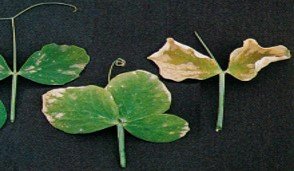 Pale grey necrosis of leaf veins (particularly the midrib) of the second oldest leaf.
This is followed by older leaf pale to pink necrotic spots, that spread until the leaf shrivels and dies.
Potash Grow
Manganese
Pale grey necrosis of leaf veins (particularly the midrib) of the second oldest leaf.
This is followed by older leaf pale to pink necrotic spots, that spread until the leaf shrivels and dies.
Potash Grow
Manganese
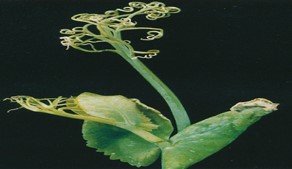 Affected leaves curl downwards along the length of the leaf . Interveinal leaf chlorosis turns into necrotic light brown spotting. Tendrils on new leaves have pale and excessively curled ends
ALP
Zinc
Affected leaves curl downwards along the length of the leaf . Interveinal leaf chlorosis turns into necrotic light brown spotting. Tendrils on new leaves have pale and excessively curled ends
ALP
Zinc
 The tissue between the veins of the leaves turns yellow or white while the veins remain green. This is often seen on the younger leaves of the plant.
Zinc Grow Caps
The tissue between the veins of the leaves turns yellow or white while the veins remain green. This is often seen on the younger leaves of the plant.
Zinc Grow Caps


